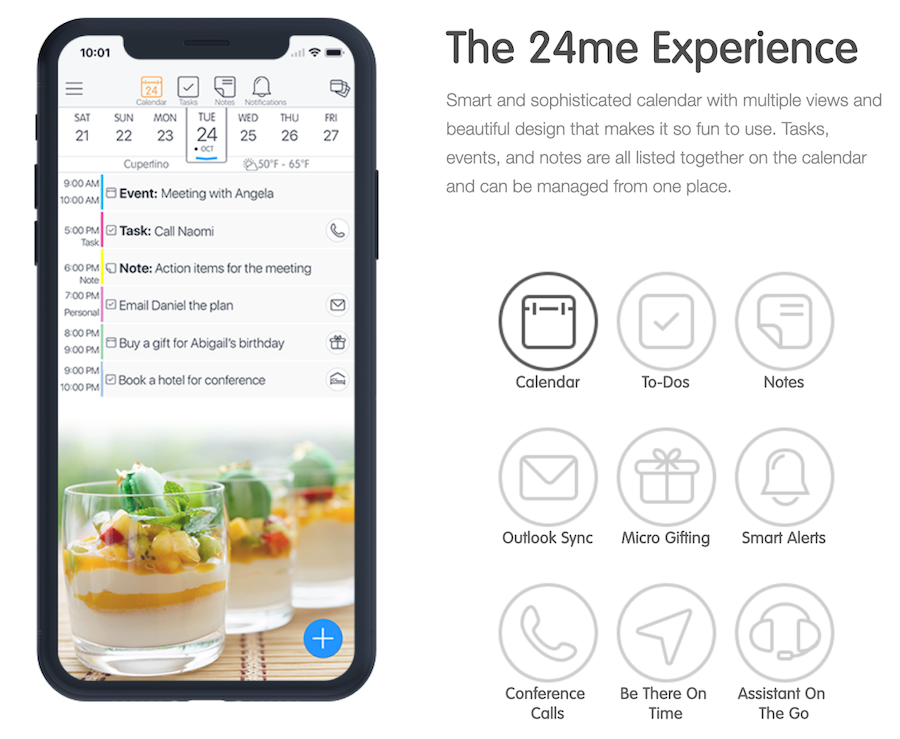Content
How 24me got a new lens into app data with Glassfy to grow revenue

The customer

24me is a startup, software-as-a-service platform that helps busy people stay on top of tasks, time, and life in general. Its users are busy professionals who are looking for a digital personal assistant: a better, more customizable and advanced tool set for sharing calendars, gathering notes, and hacking productivity in a way that competitors like Google and Microsoft Office cannot compete with.
The challenge
The product and engineering teams at 24me were growing successfully out of the gate as a self-built app, and was exercising its own strategy to deal with all of its needs. But its Growth team was starting to experience growing pains and was lacking the ability to gain insight into what was working well with user monetization and how that correlates to their marketing efforts, and ultimately what was not.
We’ve all been there: data in all shapes, sizes and formats, dumped into spreadsheets that we’ll clean up, aggregate and make sense of – someday. When we have time. 24me was dealing with that very thing, and had finally had enough.
24me had a self-built subscription management solution in place already, but the product and engineering teams recognized that they had a major blind spot aside from the traditional pains around scaling subscription management and growth: “What we were missing was a view into the behavior and performance of those subscriptions,” 24me CEO Gilad Hertanu said.
Without understanding what was happening with customers across stores, and no way to easily aggregate data that could reveal the true nature of customers’ journeys and stories, 24me’s growth team was flying blind when it came to understanding how well its business initiatives, like marketing campaigns or product offerings, were performing. That led the company to shift its strategy. It was not a small decision: 24me was already working on a sustainable solution, which meant that any outside solution needed to be worthwhile to make a change
The decision
24me’s product and engineering team examined several alternatives. But many were point solutions that didn’t address the breadth of what young tech companies require: a platform approach that takes care of a variety of needs.
“We now have a much better view about purchases made on our platform. That allows us to improve our marketing activities based on that data. We’re able to do more targeted marketing activities, and to much better track the results of those activities.” - Gilad Hertanu, 24me CEO
Most importantly, many didn’t seem versed in one of the most critical aspects of growth: analytics that reveal how a company and its product are doing. Those analytics are critical to business growth, but hard to come by in a multi-store environment where data is coming from multiple places and in many different formats. Additionally they did not have this expertise in house, so going at it alone would have been a costly project.
The solution
Ultimately, 24me made the decision to go with Glassfy. It was an easy choice; Glassfy popped out as the leading potential solution both for the complete nature of its solution and because Glassfy has a reputation for customer support and expertise in overall app monetization strategy, which they work with their clients on.
“After evaluating we found Glassfy would save us 900% of time on building and maintenance compared to other solutions.” - Gilad Hertanu, 24me CEO
“We connected Glassfy to our payment hubs and to our analytics providers, which allowed us to enrich our analytics with data about payments,” CEO Gilad Hertanu said. “The team at Glassfy were able to help us configure elements to have a reporting system that meets our goals. They were available throughout the process to discuss the details and fix any issues we found.”
A couple of examples of what this allows you to do:
- Determine how well various offerings and price points are performing
- Better targeting at the moments that matter (e.g. Glassfy notifies you when a user removes auto-renewal, that is a great moment to present that user with a new offering.)
- Marketing attribution - See how well your marketing efforts are performing based on numerous revenue metrics
In all, implementation took only a week, and with the configurations available, Glassfy met the client’s goals. “We now have a much better view about purchases made on our platform,” Hertanu said. “That allows us to improve our marketing activities based on that data. We are able to do more targeted marketing activities, and to much better track the results of those activities.”

